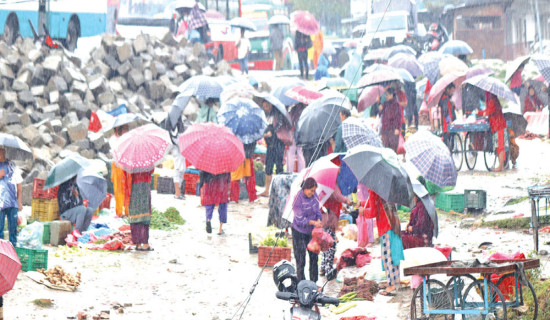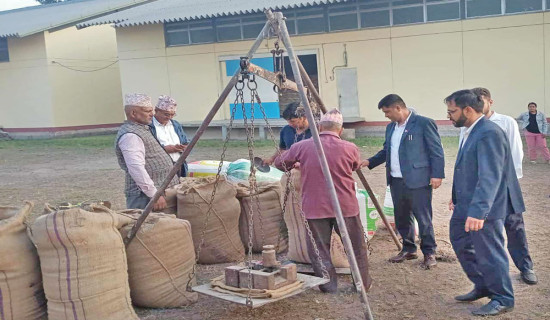- Sunday, 9 November 2025
Dashain vibes, business marred by Gen-Z movement fallout
Kathmandu, Sept. 28: As Dashain, one of Nepal's most significant and widely celebrated festivals, approaches, markets across the country—especially in the Kathmandu Valley—are witnessing a surge in consumer activity.
Popular commercial hubs such as New Road, Bishal Bazaar, Asan, Suraj Arcade, Baneshwor, Koteshwor, and others have been bustling with shoppers purchasing goods ranging from food items to clothing, electronics, and home appliances in preparation for the festivities.
However, this year’s Dashain shopping season has been impacted by the recent Gen-Z Protest. During the Gen-Z-led anti-corruption protests, approximately 22 out of the 32 Bhat Bhateni Supermarket outlets across Nepal were damaged, significantly affecting consumer shopping patterns.
As one of the country’s largest retail chains, Bhat Bhateni is more than just a place to shop—it plays a vital role in shaping consumer behaviour by offering a wide variety of goods, from daily necessities to luxury items, all under one roof.
Traditionally, Dashain and Tihar are peak seasons for consumer spending in Nepal. People, depending on their financial capacity, invest in non-food items such as clothes, gadgets, and even vehicles. This seasonal boost in spending not only enhances personal celebration but also plays a crucial role in stimulating the national economy.
Most middle and lower class families look forward to Dashain for wearing new clothes, eating delicious food, and traveling to their favourite destinations, but due to price increases and the recent Gen-Z movement across the country and the subsequent fear and panic, people are not so happy to buy things they need and want.
No business despite crowds of customers
The consumption amounts to at around 30–35 per cent of the total annual consumption during the two months of Dashain, Tihar, and Chhath.
However, due to the impact of Gen-Z protests and rising prices, traders have said that the consumption of goods, in terms of quantity, will be lower this year.
Businessmen have reported that although customer movement in the market has increased since last week, Kathmandu’s main market is not as busy as in previous years.
Traders operating in Kathmandu Valley, including New Road and Koteshwor, have expressed dissatisfaction as they have not been able to meet their expected sales targets even during the festival season, said Naresh Katuwal, founding president of the Nepal National Traders’ Federation.
Babu Kazi Basnet, a retailer in Koteshwor, said that business during this year’s Dashain has not increased like it did last year.
“Due to the protests just before Dashain, there is no joy on the faces of people who come to shop for clothes for themselves and their children. Most are only interested in buying clothes for their children,” he told The Rising Nepal.
“It is impossible to boost sales unless people’s incomes improve. Price hikes on fancy items have also affected our transactions,” he said. He added that the price of garments has increased by around 10–15 per cent compared to last year.
According to him, in his 15 years of business experience, he has never seen such low business during Dashain, except during the COVID-19 pandemic and the 2015 earthquake. He said business during this year’s Dashain has decreased by 40–45 per cent compared to last year.“The business, which had been gradually improving after COVID-19, was again affected this year by the Gen-Z protests,” Basnet said.
He added that customers who spent up to Rs. 20,000 on garments last year have reduced their spending to around Rs. 10,000 this year.
Gold trader Tej Ratna Shakya also admitted that the gold and silver business did not meet expectations during Dashain. “Gold sales have dropped by nearly 70 per cent this Dashain compared to last year. This shows that the purchasing power of the people has significantly decreased,” he said.
Daily demand for gold has fallen below 15 kg, whereas it exceeded 40 kg per day during Dashain last year.
“It is natural for gold demand to decline when there is weak trade in garments and essential goods. People usually invest in gold using their savings after covering daily expenses. But now, with reduced purchasing power, they are struggling to manage even their basic needs,” he added.
The recent surge in gold prices has also affected business this year. Gold reached a record high of Rs. 223,000 per tola on Wednesday.
Chinese imports delayed, domestic products sold
Following the closure of the Rasuwa and Tatopani trade routes for two months, hundreds of containers carrying goods from China have been stuck at the border. "Due to the containers being stranded at the border, goods including clothes meant for Dashain have not yet arrived. This has caused a shortage of goods in the market and negatively impacted business," said Katuwal.
More than 600 containers carrying Dashain-related goods—such as electronics, clothing, food items, and fruits—have been halted at Kerung.
He said that it is now impossible for these festive goods to arrive from the northern border before Dashain.
Many traders who rely on Chinese goods have been severely affected as they have been unable to retrieve their shipments stuck at the border for the past two months. "As a result, traders are compelled to sell their existing stock this Dashain, with no availability of new arrivals," Katuwal added.
He further said that business has not been up to the mark due to the price hikes and the lack of fresh products in the market. The businesses dependent on Chinese imports have seen a decline of nearly 50 per cent during this Dashain compared to last year.
Chinese products typically account for over 70 per cent of the Nepali market during the Dashain festival, as middle-income consumers prefer them due to their affordability and variety.
However, a few managed to bring in limited quantities through alternative routes, he said.
But, Katuwal noted that the sale of Nepali products have seen significant growth this year, as consumers have limited options in the absence of Chinese goods. "Traders selling Nepali products are satisfied, while those relying on Chinese imports are frustrated," he said.
Sachita Simkhada of Madhyapur Thimi, Bhaktapur, said that clothing prices have noticeably increased compared to last year.
"I came to buy clothes for my children, but the prices have risen drastically," she said. However, she also noted the lack of variety in the market, saying she was compelled to purchase whatever was available.
She said she spent around Rs. 11,000 on general clothes and shoes for her two children.
Fair price shops offer some relief
To ease the burden on consumers, the government has opened fair price shops across the country. The fair price shops have come into operation across the country since September 15.
Run by the Food Management and Trading Company (FMTC) and Salt Trading Corporation (STC), these outlets offer essentials like rice, lentils, sugar, salt, and oil at discounted rates ranging from Rs. 2 to Rs. 10 per kg/litre.
The FMTC has opened 111 outlets outside and four within the Kathmandu Valley. The STC is operating in over a dozen locations in the Valley, including Koteshwor, Kalimati, Balaju, and Jawalakhel. STC is also operating fair price shops outside the valley. Similarly, it is also operating three mobile shops to ease the consumers to purchase essential goods at discounted rates.
Spokesperson of FMTC Madhav Mishra said that they have received good response from the consumers visited the fair price shops operate by the FMTC from its four outlets inside and 111 outlets outside the Kathmandu Valley.
Mishra said that essential goods worth around Rs. 12.5 million have been sold daily from its outlets.
He claimed that this initiative of the government to run the fair prices even in this abnormal situation of Gen-Z movement had become more effective this year.
Vigilance in marketplace
The Department of Commerce, Supplies and Consumer Protection has intensified its vigilance this season.
Director of the department Bharat Prasad Acharya explained that six monitoring teams have been deployed across the Kathmandu Valley to check practices such as hoarding, tampering with scales, selling expired or substandard goods, and inflating prices beyond reason.
“Two additional mobile units have been sent along the Kathmandu–Mungling route and the BP Highway,” Acharya said, noting the abnormal traffic and rising food costs along these lifelines.
Encouragingly, he observed fewer consumer complaints this year compared to last Dashain, hinting at a slight improvement in market discipline.
The Department is not working alone. The Nepal Oil Corporation, Food Management and Trading Company (FMTC), Salt Trading Corporation (STC), and the Department of Livestock Services have all stepped in to monitor their respective sectors.
Acharya, however, underscores that consumer awareness is equally crucial. “People must check prices and quality, and immediately report suspicious practices,” he urged.According to him, only one or two teams will be mobilised for market monitoring during the Dashain holidays.
FMTC's decades-long goat sales halted
Due to the unusual circumstances created by the nationwide Gen-Z protests on September 8-9, FMTC had to postpone preparations for the sale of goats and chyangra during Dashain this year, Mishra said. “We had already started the process of selling goats during the festival this year and online bookings for consumers to purchase goats had been started. But the protests have put a stop to it,” he said.
The FMTC has been selling live goats in Kathmandu during the festive season for decades with the aim of controlling artificial price rise during Dashain, when demand for meat is high.
Mishra said that FMTC is observing the goat market this year and we are analying how our presence is going to control price hikes during the Dashain festival. "This analysis will be fruitful in strengthening our presence to control market price of goat during Dashain in the coming years," he said.
FMTC sells 1500-1800 goats annually in Kathmandu Valley during Dashain every year. Although this number is much less than the demand in Kathmandu Valley, it has contributed to controlling artificial price hikes in the market.
Not only that, the prices fixed by FMTC have also provided a basis for consumers to bargain when buying goats from private traders.
There are no official statistics of the total number of animals and chickens that get sacrificed during Dashain across the country. However, approximately 700,000 live goats are slaughtered throughout the country during Dashain.
About 50,000 goats, including mountain goats, are expected to be consume in the Kathmandu Valley, said Hari Singh Bhat, veterinary officer at the Department of Livestock Services.

















